The Saga of Silverback Inshuti
By Gorilla Doctors Staff on Tuesday, March 20th, 2012 in Uncategorized.By Dr. Dawn
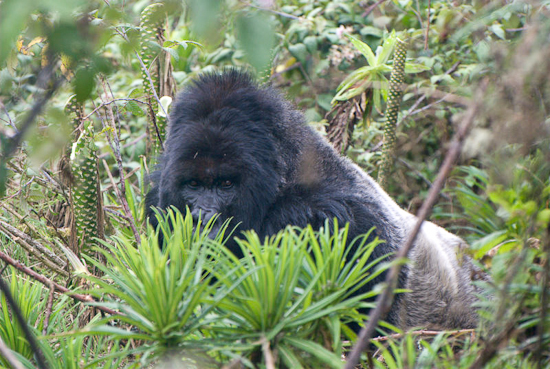 InshutiIt’s been a difficult 2012 thus far for Inshuti, a silverback gorilla in Rwanda’s Volcanoes National Park. Meaning “friend” in Kinyarwanda, Inshuti is considered one of the largest and most aggressive silverbacks within the Karisoke research groups, and he has endured his share of drama. Over the years, Inshuti has survived attacks from other gorillas, a suspected fall, and a respiratory infection.
InshutiIt’s been a difficult 2012 thus far for Inshuti, a silverback gorilla in Rwanda’s Volcanoes National Park. Meaning “friend” in Kinyarwanda, Inshuti is considered one of the largest and most aggressive silverbacks within the Karisoke research groups, and he has endured his share of drama. Over the years, Inshuti has survived attacks from other gorillas, a suspected fall, and a respiratory infection.
At 16 years of age, Inshuti left Shinda group to become a lone silverback in search of a family. Just months later, he met the Beetsme’s group and was beaten badly by a number of gorillas. He spent three days in his night nest, a sign of critical concern, then suddenly emerged and continued to forge on.
In 2007, after various unsuccessful attempts to acquire some females over his three years of bachelorhood, he was joined by two females from Titus group, Taraja and Shangaza. In 2008, Shangaza gave birth to a female named Ngwino, and Taraja produced a male, Akarusho, in 2009. A third female, Nyandwi, joined in 2011 from Pablo group. Inshuti had finally secured a growing family.
His blissful life of female companionship did not last long.
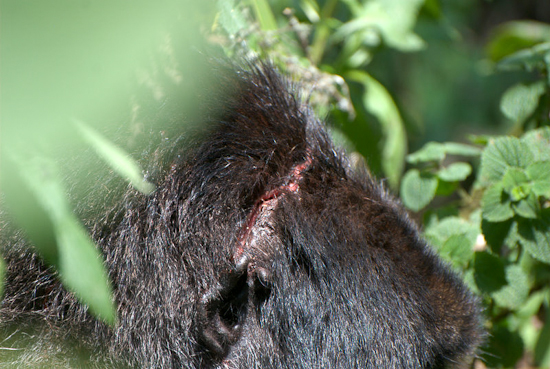 Inshuti’s head wound.On Friday, January 27, I received a call from Karisoke Gorilla Program Coordinator Veronica Vecellio reporting that Inshuti had sustained severe wounds from an interaction with two lone silverbacks. Karisoke researchers had witnessed the interaction, which lasted for over 2 hours and left Inshuti with bite wounds to the head, neck, back, hands, and feet. The two lone silverbacks were identified by Karisoke as Tuyizere and Turatsinze, originating from Pablo group, and had continued to follow Inshuti after the interaction.
Inshuti’s head wound.On Friday, January 27, I received a call from Karisoke Gorilla Program Coordinator Veronica Vecellio reporting that Inshuti had sustained severe wounds from an interaction with two lone silverbacks. Karisoke researchers had witnessed the interaction, which lasted for over 2 hours and left Inshuti with bite wounds to the head, neck, back, hands, and feet. The two lone silverbacks were identified by Karisoke as Tuyizere and Turatsinze, originating from Pablo group, and had continued to follow Inshuti after the interaction.
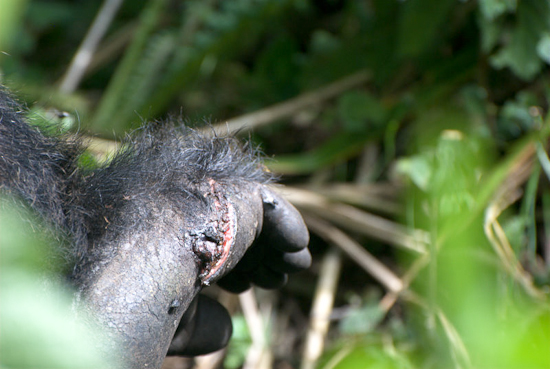 Inshuti’s injured foot
Inshuti’s injured foot
A veterinary assessment was requested, and the next morning, Dr. Jean-Felix and I trekked up to the Basumba area which lies between the Bisoke and Karisimbi volcanoes. We were joined by Dr. Winnie Eckardt, a Karisoke post-doctoral researcher, and numerous Karisoke trackers who knew the group well, as Inshuti’s aggressive reputation warranted many bodies for protection should an intervention be needed. Along the way, we came across one of the lone silverbacks, Turatsinze, with a few minor wounds on his back.
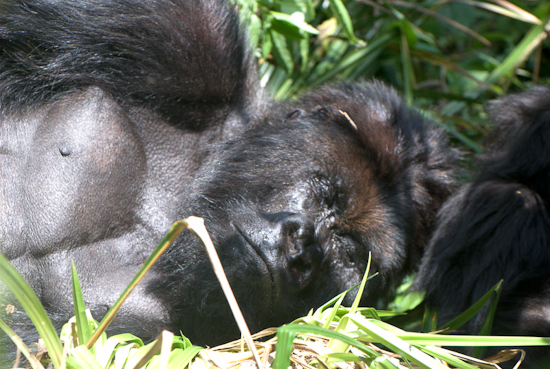 Inshuti feeling badly.
Inshuti feeling badly.
We found Inshuti lying on his belly, often a pose associated with not feeling well. He seemed to care less that we were there, unusual for him. He was quite weak and sore but alert, responsive, and eating. He was moving very slowly and we discovered the reason – a large wound on the sole of his right foot. As a mature silverback, he is likely close to 200 kg in weight, and as gorillas walk on the knuckles of their hands and the soles of their feet, a significant percentage of their weight is distributed to each foot.
We followed him to his next resting place, sadly only a few meters away, and watched him for over an hour documenting his wounds and looking for any signs of serious internal injuries (such as blunt trauma or deep puncture wounds impossible to observe by visual examination at 7+ meters away). His abdomen was fairly flat, a sign that he had not eaten much in the last 24 hours. Numerous other bite wounds were observed, including a severe laceration to his head: approximately 20 cm in length and 1 cm in depth, scaling from his right ear to the top of his head. Although this wound was of significant concern, it did not appear life-threatening and therefore did not warrant an intervention.
A Gorilla Doctor protocol, the decision to intervene is based on whether the injury or illness is human-induced and whether the injury or illness is life-threatening. In Inshuti’s case, his wounds did not appear to be immediately life threatening, and undergoing anesthesia could weaken him further, making him an easier target for the lone silverbacks who had continued to follow the group. We decided to not to intervene but monitor his wounds and if signs of infection were observed, we would be ready to dart with antibiotics. The Karisoke trackers would stay and watch him for the next several hours and check on him daily.
The next day, the trackers reported that Inshuti was not eating nor moving much. Although this would not be unusual if feeling sore, it was still of concern that the wounds may have been worse than our visual inspection suggested. While preparing to return for a possible intervention, we waited anxiously for the next report. The call came mid-day . . . he was eating and moving around much more! We breathed a sigh of relief, but still scheduled a visual recheck for the next day.
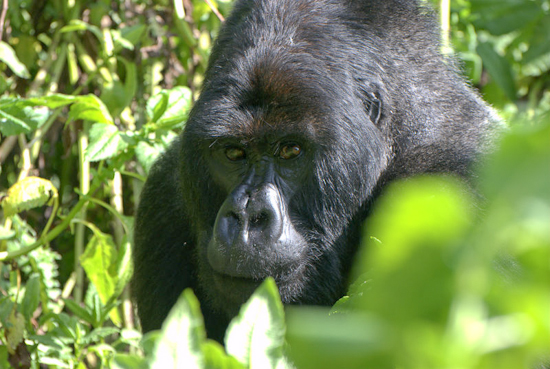 TuyizereDr. Jean Felix confirmed Inshuti’s improved condition; however, during the veterinary health check, Inshuti had another interaction with Tuyizere. Inshuti was seen charging Tuyizere many times to prevent him from getting close to the females but no physical contact was observed. Inshuti did not display any signs of weakness or pain when displaying and running the lone silverback off, and his wounds appeared to be healing well. This, at least, was good news that he was feeling well enough to defend himself. Nyandwi, only nine years old and without an infant, appeared as if she wanted to go with Tuyizere, but Inshuti would run after her and pull her back. Despite such advances, Inshuti’s group remained intact.
TuyizereDr. Jean Felix confirmed Inshuti’s improved condition; however, during the veterinary health check, Inshuti had another interaction with Tuyizere. Inshuti was seen charging Tuyizere many times to prevent him from getting close to the females but no physical contact was observed. Inshuti did not display any signs of weakness or pain when displaying and running the lone silverback off, and his wounds appeared to be healing well. This, at least, was good news that he was feeling well enough to defend himself. Nyandwi, only nine years old and without an infant, appeared as if she wanted to go with Tuyizere, but Inshuti would run after her and pull her back. Despite such advances, Inshuti’s group remained intact.
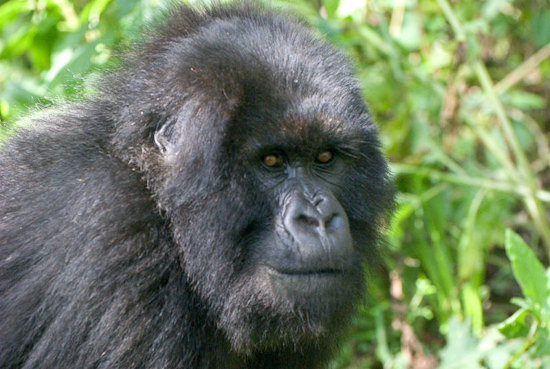 Nyandwi
Nyandwi
However, the very next day, Karisoke trackers reported an interaction with yet another lone silverback, 17-year-old Giraneza, who also originated from Pablo group. The next, day, Inshuti and his group went missing.
No sign of them could be found for the next 5 days. Karisoke trackers searched intensely starting from the trail on the last day they were seen, even employing a second Karisoke patrol, but to no avail.
A main concern was that another interaction had led to group to flee so quickly that they left no trace of their path behind. And assuming there had been another interaction, we needed to find him soon to assess his health. Further complicating things was the thought that they may have fled across the border into the Democratic Republic of Congo.
GiranezaFinally, trackers found Nyandwi, not with Inshuti but with the lone silverback, Giraneza. Five days after going missing, Karisoke trackers found Inshuti. He was alone and weak, but still moving and eating. Just one kilometer away, the lone silverback Giraneza and female Nyandwi had been joined by Taraja and her infant Akarusho. This was concerning for almost 3-year old Akarusho as infanticide is not uncommon in gorilla groups where the dominant silverback is not the sire.
The same day, lone silverback Turatsinze approached the group and fought with Giraneza. The group dispersed during the interaction. Afterwards, Akarusho did not return to the group and was not seen for the rest of the day. Meanwhile, Shangaza and infant Ngwino had not been found.
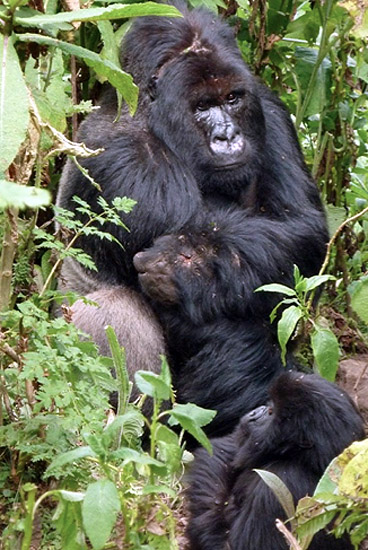 Akarusho and InshutiFortunately, the next morning, Akarusho joined Inshuti, stressed after spending a night alone for the first time, but otherwise fine. Karisoke researchers reported that he cried when he saw Inshuti and remained close to him for the rest of the day. Inshuti remains weak but moving and feeding, and still recovering from wounds of the initial attack almost two weeks ago.
Akarusho and InshutiFortunately, the next morning, Akarusho joined Inshuti, stressed after spending a night alone for the first time, but otherwise fine. Karisoke researchers reported that he cried when he saw Inshuti and remained close to him for the rest of the day. Inshuti remains weak but moving and feeding, and still recovering from wounds of the initial attack almost two weeks ago.
On February 10th, Dr. Jean Felix returned to check on Inshuti’s condition. He found Inshuti very active, with the majority of his wounds healing well with exception of the one located behind his left ear extending to his neck which was still open and probably taking longer to heal as the laceration was pulled open when Inshuti moved his head to the side.
Ngwino
Two days later, Shangaza and infant Ngwino joined Inshuti, looking fine and healthy. After one of the few lone silverbacks to successfully acquire a family group, and then lose one, it appears that Inshuti once again has a family.
Weeks later, Inshuti’s group was found on Karisimbi, quite far from their normal territory. It is not known whether they continue to run from lone silverbacks, or if, perhaps, Inshuti is looking for his lost females.
You can follow the Gorilla Doctors health monitoring efforts on our Facebook page, where we post photos and notes from our monthly visits.
Please consider supporting MGVP by making a secure online donation. Every dollar you give goes to directly supporting our gorilla health programs and One Health initiative. Thank you for your generosity.


 Donate
Donate